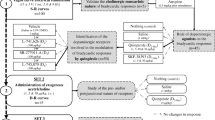Summary
Atropine-induced bradycardia is traditionally ascribed to central vagal stimulation, although bradycardia has also been observed after administration of quarternary amines. Pirezepine, a selective M1-antagonist, causes bradycardia in therapeutic doses for which a peripheral mechanism is postulated. This hypothesis has been investigated in healthy volunteers.
Atropine 0.5 mg caused significant bradycardia from 210 min and pirenzepine 10 mg after 60 min. After prior beta-blockade, the bradycardic action of the anti-cholinergic drugs was more marked. Pirenzepine-induced bradycardia was reversed by higher doses of atropine.
It is suggested that atropine- and pirenzepine-induced bradycardia results from M1-blockade of sympathetic ganglia. In addition, low concentrations of atropine and therapeutic doses of pirenzepine may cause an increase in acetylcholine, perhaps due to a presynaptic effect on nerve endings.
Similar content being viewed by others
References
Wood HC (1888) Therapeutics its principles and practice (7th edn). Smith, Elder, London, pp 202–252
Sollmann T (1936) A manual of pharmacology (5th edn). W.B.Saunders, Philadelphia, pp 357–371
McGuigan H (1921) The effect of small doses of atropin on the heart rate. J Am Med Assoc 76: 1338–1340
Weiner N (1985) Atropine, scopolamine, and related antimuscarinic drugs. In: Gilman A, Goodman LS, Rall TW, Murad F (eds) The pharmacological basis of therapeutics (7th edn). Macmillan, New York, pp 130–144
Heinekamp WJR (1922) The central influence of atropine and hyoscine on the heart rate. J Lab Clin Med 8: 104–111
Rudolf RD (1924) Some cardiac effects of atropine. Am J Med Sci 168: 641–647
Neeld JB, Allen AT, Coleman E, Frederickson EL, Goldberg LI (1975) Cardiac and rythm changes with atropine and methscopolamine. Clin Pharmacol Ther 17: 290–295
Kottmeier CA, Gravenstein JS (1968) The parasympathomimetic activity of atropine and atropine methylbromide. Anesthesiol 29: 1125–1133
Konturek SJ, Obtulowicz W, Kwiecién N, Dobrzánska M, Swierczek J, Kopp B, Olesky J (1980) Effects of pirenzepine and atropine on gastric secretory and plasma hormonal responses to shamfeeding in patients with duodenal ulcer. Scand J Gastroenterol 15: 63–66
Carmine AA, Brogden RN (1985) Pirenzepine: A review of its pharmacodynamic and pharmacokinetic properties and therapeutic efficacy in peptic ulcer disease and other allied diseases. Drugs 30: 85–126
Hammer R (1981) Subclasses of muscarinic receptors and pirenzepine further experimental evidence. Scand J Gastroenterol 17 [Suppl 72]: 59–64
Hammer R (1980) Muscarinic receptors in the stomach. Scand J Gastroenterol 15 [Suppl 66]: 5–11
Jaup BH, Blomstrand CJ (1980) Cerebro-spinal fluid concentrations of pirenzepine after therapeutic dosage. Scand J Gastroenterol 15: 35–37
Wiffert D, Davidesko D, Timmermans PBMWM, van Zwieten PA (1983) Differential role of M1- and M2-receptors in sympathetic ganglia of the pithed normotensive rat in alpha adrenoreceptor-mediated vasoconstriction. J Pharmacol Exp Ther 226: 855–860
Sommers De K, Schoeman HS (1987) Cardiac effects of pirenzepine. S Afr J Sci 83: 368–369
Morton HJV, Thomas ET (1985) Effect of atropine on heartrate. Lancet 2: 1313–1315
Cullumbine H, McKee WHE, Creasey NH (1955) The effects of atropine sulphate upon healthy male subjects. Q J Exp Physiol 40: 309–319
Author information
Authors and Affiliations
Rights and permissions
About this article
Cite this article
Meyer, E.C., De Sommers, K. Possible mechanisms of anti-cholinergic drug-induced bradycardia. Eur J Clin Pharmacol 35, 503–506 (1988). https://doi.org/10.1007/BF00558245
Received:
Accepted:
Issue Date:
DOI: https://doi.org/10.1007/BF00558245



